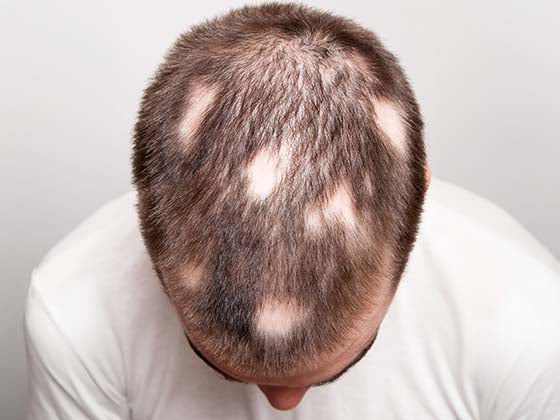The use of hydrogen peroxide in hair treatment involves several issues. This chemical compound, also known as hydrogen peroxide, is widely used to bleach or lighten hair and is both popular for its quick results and feared for its possible damage to the hair fiber. Using hydrogen peroxide? Is this a positive or negative idea?
What Is Hydrogen Peroxide and How Does It Lighten Hair?

Hydrogen peroxide is a strong oxidizing agent that produces oxygen when it comes into contact with other substances, which explains why it is employed in a variety of applications, from antiseptics in first-aid kits to hair whitening agents. It is best recognized in the hairdressing industry for its function in discoloration and coloring, where it is used to open the hair cuticles to remove or deposit pigment. Its concentration typically ranges between 3% for home usage and up to 12% in professional formulations. The latter is used for more advanced lightening and bleaching. Although widely used, it must be handled with caution because high doses might harm hair and skin.
How it works.
-
Oxidizing Agent: Hydrogen peroxide is an oxidizing agent, which means it degrades the pigment molecules in your hair. Natural pigments, primarily melanin, determine the darkness or lightness of your hair. When hydrogen peroxide is administered, it interacts with melanin, breaking it down and lightening the hue.
-
Breaking down melanin: Specifically, hydrogen peroxide destroys the molecular links between melanin molecules, reducing their ability to absorb light and making the hair seem lighter.
-
Effect on hair structure: The oxidation process not only degrades melanin but also changes the structure of the hair. This is why peroxide can make your hair appear dry or damaged: it alters the usual structure of the strands. This is why many people report needing to continue with conditioning treatments after using it.
The Science Behind Peroxide’s Hair Lightening Process

Hydrogen peroxide is widely used to lighten hair. It can be used alone or with other blonde dyes. Hair dye containing hydrogen peroxide is considered permanent, which means it will only fade as new hair grows. This is because hydrogen peroxide works in the hair cortex, which is the innermost portion of the hair and contains the pigment that gives hair its color. Hydrogen-peroxide-based dyes alone can help you get a light blonde tint. These colors are also commonly used to lighten black hair before applying another color of dye. It has been known to turn dark brown hair red.
Why Peroxide Is a Popular DIY Hair Bleach

Hydrogen peroxide has gained popularity as a DIY hair bleach for a variety of reasons. Here's why so many people use it to lighten their hair at home.
-
Affordability: Hydrogen peroxide is far cheaper than professional hair bleaching products or salon treatments. Most drugstores sell a bottle for a few dollars, making it a reasonable solution for those on a limited income.
-
Accessibility: It is frequently offered online, at pharmacies, and in supermarkets. Most people have it on hand as a cleaning or first-aid solution, and it's easy to locate. For those who want to try whitening their hair without seeing a professional, this makes it perfect.
-
Effectiveness at lightening: It is a vigorous oxidizing agent, hence it can efficiently lighten hair. It is great for anyone who wants to go a few shades lighter because it breaks down melanin, the pigment in hair. It can give you a lighter or blonde appearance when applied properly.
-
DIY control: For people who enjoy experimenting with their appearance or want to save money on a professional treatment, peroxide provides a do-it-yourself option that allows them to manage the process. You can use it any way you like, at your own pace, and experiment with various ways (such as highlights or general lighting).
-
Sunlight activation: Some people report that hydrogen peroxide works well when combined with sun exposure. When you apply it to your hair and sit in the sun, the heat will accelerate the oxidation process, resulting in faster lightening. This is why some individuals prefer to use it during the summer, when the peroxide can be combined with natural sunshine to create a DIY sun-kissed effect.
-
Customizable results: The length of time hydrogen peroxide is left on the hair affects its lightening impact. Rinse it out after 10-15 minutes to make a slight improvement. You can keep it on longer for a more dramatic lightening effect (but proceed with caution to avoid excessive damage).
-
Professional help: Many people are tempted by the prospect of saving time and money by not having to visit a salon. With a little research or trial and error, you may lighten your hair at home without making an appointment.
How Peroxide Affects Your Hair Structure

Hydrogen peroxide does more than just brighten your hair; it also has important structural effects. When you use peroxide, it can create chemical and physical changes to your hair, not all of which are desired. Peroxide disrupts your hair's cuticle layer, breaks down disulfide bonds, oxidizes melanin, causes moisture loss, and weakens the keratin structure.
Potential Risks and Damage from Hydrogen Peroxide

While hydrogen peroxide can make your hair lighter and brighter, you should be aware of the hazards and harm it might cause. Overuse or poor application can have various negative effects on your hair and scalp. The primary concerns to consider include hair breakage and brittleness, loss of moisture, scalp irritation, uneven lighting, over-processing, color changes, and the possibility of long-term damage.
Common Side Effects of Peroxide on Hair

Hydrogen peroxide can have some significant adverse effects on your hair, especially if applied incorrectly or too frequently. The most prevalent adverse effects include dryness and brittleness, scalp irritation, color changes, weakening and thinning, uneven lighting, increased porosity, and scalp injury.
Signs of Peroxide-Induced Hair Damage

Hydrogen peroxide is effective for whitening hair, but if used poorly or excessively, it can cause obvious damage. Excessive dryness and rough texture, breakage and split ends, increased porosity, uneven texture or color, elasticity loss, frizz and lack of shine, itchy, red, or inflammatory scalp, and hair loss are some of the most typical indicators of peroxide damage to hair.
Scalp Irritation and Safety Concerns

When using hydrogen peroxide on your hair, keep in mind that it can cause scalp irritation and raise safety concerns. While it is a potent lightening agent, if not utilized carefully, it can cause discomfort or even long-term damage. Here are some essential facts about scalp irritation and safety when using hydrogen peroxide:
-
Scalp irritation: Hydrogen peroxide can be harsh on the scalp, especially if administered for an extended period, at a high concentration, or directly to inflamed skin. Scalp irritation symptoms include a burning or stinging feeling, itching or redness, peeling or flaking, and pain.
-
Chemical burns: If hydrogen peroxide is applied to the scalp for an extended period of time, particularly at higher concentrations (more than 3%), the skin can be burned. This occurs because peroxide, an oxidizing chemical, can harm the skin's outer layers if overexposed.
-
Safety precautions: To avoid irritation and ensure the safe use of hydrogen peroxide on your hair, avoid direct scalp contact, patch test, protect your skin, do not over-apply, and rinse well.
-
Signs of overuse or misuse: Using hydrogen peroxide too regularly might aggravate scalp irritation and create long-term harm. Overuse can cause increased sensitivity, chemical burns, and dry, flaky skin on the scalp.
-
Avoiding long-term damage: Long-term usage of hydrogen peroxide should be avoided by persons with sensitive scalps or who have previously suffered irritation. Continuous exposure can weaken the skin's protective barrier over time, resulting in chronic irritation, dryness, and, in extreme cases, hair thinning.
Tips for Safely Lightening Hair with Hydrogen Peroxide

If you're thinking about using hydrogen peroxide to lighten your hair, there are ways to reduce the hazards and achieve the best results while keeping your hair and scalp healthy. Some tips for safely lightening hair with hydrogen peroxide include using a low concentration, performing a patch test first, avoiding scalp contact, keeping application even, limiting exposure time, rinsing thoroughly, deep conditioning after treatment, protecting your hair from further damage, monitoring the results, and adjusting for future use.
Preparing Your Hair Before Lightening

Preparing your hair before using hydrogen peroxide to lighten it is crucial for minimizing damage and ensuring the best results. The healthier your hair is before you start, the better it will respond to the lightening process. Here are some steps to properly prepare your hair before lightening with hydrogen peroxide:
-
Ensure your hair is healthy: Before using hydrogen peroxide, make sure your hair is in good condition. Damaged hair is more prone to breakage, dryness, and frizz after lightening, so it's best to restore it as much as possible beforehand. Avoid lightening hair that’s already been chemically treated (like colored or permed hair) unless you’ve given it time to recover. Trim split ends and remove any damaged or overprocessed sections. Healthy hair will withstand the peroxide treatment better.
-
Deep condition beforehand: Hydrogen peroxide can strip moisture from your hair, so you’ll want to ensure it’s as hydrated as possible before lightening. Use a deep conditioning treatment a day or two before you plan to lighten your hair. Choose a moisturizing or protein-rich deep conditioner that can restore strength and elasticity. Leave it on for 10–15 minutes to allow the nutrients to penetrate and nourish your hair. Apply the deep conditioner to damp hair, cover with a shower cap, and let it sit for at least 10-20 minutes before rinsing. For extra hydration, you can wrap your hair in a warm towel.
-
Avoid washing your hair: It’s a common misconception that you should apply hydrogen peroxide to clean hair. In fact, applying it to dirty or slightly oily hair can actually protect your scalp from irritation and prevent the peroxide from absorbing too quickly. Try not to wash your hair for 1-2 days before using peroxide. This allows your natural oils to form a barrier on your scalp and will prevent irritation. If you must wash your hair, use a gentle shampoo and avoid any harsh clarifying shampoos, which can strip the hair of moisture.
-
Avoid using heat styling tools: Before lightening your hair, give it a break from heat styling tools like flat irons, curling irons, and blow dryers. These can dry out and weaken your hair, making it more vulnerable to damage during the peroxide process. Let your hair air-dry or style it without heat for a few days before applying hydrogen peroxide. Try leaving your hair natural, or use a heatless styling method (like braiding for waves) to keep your hair in good condition.
-
Protect your scalp and hairline: To minimize irritation and protect your skin from peroxide, apply a protective barrier around your hairline, ears, and neck. Petroleum jelly, a thick conditioner, or even coconut oil can work well for this. Apply a generous amount of petroleum jelly to the areas where the peroxide might touch your skin. This will help prevent irritation and burns. Use a cotton swab or your fingers to apply the jelly to the scalp area where you’re most likely to get peroxide on your skin.
-
Allergies and sensitivities: Hydrogen peroxide can cause irritation or allergic reactions for some people. Always perform a patch test to check for any sensitivities before using it on your hair. Apply a small amount of hydrogen peroxide behind your ear or on the inside of your wrist and leave it for 24 hours. If you notice any redness, swelling, or discomfort, it may be best to avoid using it on your hair. If no irritation occurs after 24 hours, you're good to go!
-
Detangle your hair: Before applying hydrogen peroxide, it’s important to remove any tangles or knots in your hair. This will help the product spread evenly and avoid areas where it may not be properly applied. Use a wide-tooth comb or your fingers to gently detangle your hair before starting. Be gentle to avoid causing breakage, and make sure your hair is fully detangled before you apply peroxide.
-
Don’t overdo the products: While you want to protect your hair, avoid using heavy oils or leave-in treatments immediately before applying hydrogen peroxide, as these can create a barrier that prevents the peroxide from effectively lightening your hair. If you're planning on using hydrogen peroxide to lighten your hair, skip heavy styling products or oils right before. Stick to lightweight leave-ins that won’t interfere with the process. If you typically use oils or serums, consider skipping them for a day or two before your lightening treatment to allow the peroxide to work more efficiently.
-
Right tools ready: Gather the tools you’ll need for the lightening process to make it smooth and easy. Having everything prepared in advance will save time and reduce the chances of applying peroxide incorrectly. You’ll need a plastic or glass bowl for mixing the hydrogen peroxide, a hair dye brush for application, and plastic gloves to protect your hands. Set up your application station in a well-lit area and wear an old shirt to avoid getting any peroxide on your clothing.
Step-by-Step Guide to Using Peroxide on Hair

Using hydrogen peroxide to lighten your hair can be effective, but it requires a careful, step-by-step approach to ensure safety and minimize damage. Here's a step-by-step guide to using peroxide on your hair:
-
Step 1: Prepare Your Hair: Before using hydrogen peroxide, ensure that your hair is healthy and adequately prepared. Avoid shampooing your hair just before using peroxide; instead, wait a day or two to allow your natural oils to protect your scalp. Detangle your hair so the peroxide may be applied evenly. Protect your scalp and hairline: To avoid peroxide irritation, apply a thin coating of petroleum jelly or conditioner to your hairline, ears, and neck.
-
Step 2: Prepare the peroxide solution: Prepare the peroxide solution by mixing hydrogen peroxide in a plastic or glass dish. You can use 3% hydrogen peroxide straight from the container, or dilute it with a little water for a softer impact. Make sure the peroxide is fresh and hasn't been opened for a long time, as its strength can deteriorate with time.
-
Step 3: Section your hair: Divide your hair into parts to achieve an even application. Use clips to divide your hair into four or more manageable sections (depending on thickness). The smaller the parts, the more consistent your application will be.
-
Step 4: Apply hydrogen peroxide: Now is the time to apply the peroxide! Wear gloves to protect your hands. If you want to lighten your hair all over, start at the tips. If you're looking for certain locations (such as roots), start there first. To apply peroxide to your hair, use a color brush or an applicator bottle. Work the peroxide through the strands to ensure it is evenly dispersed. You can massage the product into your hair if necessary. Avoid applying directly to your scalp whenever possible, as this can cause irritation or burns. Focus on the lengths and ends to achieve a more natural gradient.
-
Step 5: Let the peroxide sit: After applying the peroxide, you need to let it process. The amount of time depends on how light you want your hair to be. Leave the peroxide on for 10–15 minutes. Leave it on for 20–30 minutes, but keep checking your hair every 5 minutes to monitor the progress and prevent over-processing.
-
Step 6: Rinse thoroughly: Once you reach your desired level of lightness, rinse your hair thoroughly with cool water to stop the lightening process. You want to make sure all the peroxide is washed out to prevent continued processing.
-
Step 7: Shampoo and condition: Shampoo your hair with a gentle, hydrating shampoo to remove any leftover peroxide and impurities. Follow with a deep conditioner or moisturizing treatment to restore moisture and nourish your hair after the treatment.
-
Step 8: Aftercare and protection: After lightening, your hair will likely be more porous and prone to dryness. Take good care of it to restore its health. Deep condition regularly to keep your hair hydrated and nourished. Avoid heat styling for a while to reduce further damage. If you must use heat, apply a heat protectant to minimize the effects of hot tools. Moisturize your hair with oils or leave-in conditioners to keep it shiny and smooth.
-
Step 9: Monitor the results: Check how your hair looks after the treatment. If you're happy with the results, continue with your regular hair care routine. If you want more lightening, you can repeat the process in one or two weeks, but be cautious not to overdo it, as frequent peroxide use can lead to significant damage.
Post-Bleaching Hair Care for Damage Repair

After using hydrogen peroxide (or any bleach) to lighten your hair, you must prioritize post-bleaching hair care to help heal any damage while also restoring moisture and strength. Bleaching can make your hair more fragile, dry, and porous; consequently, a thorough aftercare regimen is essential for preserving the health and integrity of your hair. Here's a comprehensive guide to help you recover your hair after lightening, including deep conditioning, protein treatments, hydrating hair oils, and leave-in conditioners; avoiding heat styling; trimming frequently; protecting hair from the sun and chlorine; using sulfate-free shampoos; being gentle with wet hair; avoiding chemical treatments; staying hydrated; and eating a balanced diet.
Alternatives to Hydrogen Peroxide for Healthier Hair Lightening

Some of the best alternatives:
-
Lemon juice: Lemon juice is a popular natural lightener due to its acidic qualities and the presence of vitamin C. It can lighten hair by gradually breaking down melanin, particularly when stimulated by sunlight. Mix lemon juice and water in a 1:1 ratio and apply it to your hair. For the best outcomes, sit in the sun for 30 minutes to 1 hour. The sun makes lemon juice more effective in lightening your hair. Lemon juice can be drying, so use a leave-in conditioner afterward to restore moisture to your hair.
-
Chamomile tea: Chamomile tea is a gentle, natural lightener that is especially effective for persons with blonde or light brown hair. It is also calming and can give your hair a beautiful sheen. Brew a strong cup of chamomile tea (4-5 tea bags) and let it cool before pouring it over your hair. You can also use a spray bottle to apply it. Leave it in your hair for about an hour (or longer for a more dramatic effect) before rinsing. Chamomile is a modest lightener, therefore several applications may be required for significant results.
-
Honey and cinnamon: Honey has natural bleaching capabilities because of the small quantity of hydrogen peroxide it contains, and cinnamon enhances the lightening effect. The mixture also functions as a deep conditioner, making it a viable option for healthy lightening. To form a paste, combine honey, cinnamon powder, and a small amount of olive oil or conditioner. Apply it to damp hair and let it sit for 1-2 hours. To speed up the lightening process, cover your hair with a plastic cap and expose it to heat, such as a blow dryer. This approach works best when left on overnight, but be patient; it may take several applications to see substantial results.
-
Apple cider vinegar: Apple cider vinegar (ACV) can help lighten hair, enhance gloss, and remove product buildup. It can open the hair cuticle, allowing natural lightening agents (such as sunlight) to permeate the hair shaft. Mix one part apple cider vinegar and six parts water. After shampooing, apply the mixture to your hair and leave it for around 10 minutes. Rinse well. This can be done multiple times each week for gradual whitening and helps to regulate your scalp's pH.
-
Baking soda: Baking soda is another natural option that helps lighten hair by gently removing debris and lifting some color. However, it should be used with caution because overuse can cause dryness. To make a paste, combine baking soda and a little water. Apply it on damp hair for 10-15 minutes, then thoroughly rinse. To help refill moisture in your hair after using baking soda, apply a deep conditioner afterward.
-
Rhubarb root: Rhubarb root is a natural lightener that works especially well for persons who have darker blonde or light brown hair. When used consistently, it can provide subtle golden or reddish accents. To create rhubarb tea, boil the root in water for around 30 minutes. Let it cool before applying it to your hair. You may leave it on for up to an hour, depending on how bright you want it. Rhubarb root works best on hair that is already light, yet it is gentler than chemical bleach.
-
Aloe vera: Aloe vera includes enzymes that can help lighten hair naturally by increasing hair growth and improving general scalp health. While it may not result in dramatic lighting, it is an excellent choice for individuals seeking a modest, healthy lift. Apply fresh aloe vera gel to your hair and scalp, let it sit for 30 minutes to an hour, and then rinse it off. You can also combine it with lemon juice for an additional lightening effect. Aloe vera is soft enough to be used on a regular basis, and it moisturizes and nourishes your hair simultaneously.
-
Vitamin C: It is an excellent natural lightener since it helps fade hair coloring and lightens hair somewhat by breaking down color pigments. It works well for those looking to remove past color treatments or lighten their hair slightly. Crush some vitamin C tablets and combine with a little water to make a paste. Apply to moist hair and let it sit for 30-60 minutes before thoroughly rinsing. This procedure may not be as successful on really dark hair, but it is ideal for fading or dyed hair.
-
Coconut oil and lemon juice: Combining the hydrating benefits of coconut oil with the lightening effects of lemon juice yields a nourishing treatment that lightens hair while keeping it healthy and hydrated. Combine coconut oil and lemon juice in a 2:1 ratio. Apply to moist hair and let on for at least an hour, preferably with heat from a blow dryer to boost the lightening effect. The oil keeps the lemon juice from drying out, making this approach gentler than using lemon juice alone.
-
Saltwater spray: Saltwater can give hair a natural beachy look by lightening it in the same manner that the sun does. It's very useful for creating highlights and a sun-kissed appearance. Dissolve salt with warm water and store in a spray bottle. Mist it lightly on your hair and sit in the sun for 20-30 minutes. Because saltwater can be drying, use an excellent moisturizing treatment afterward to replace moisture.
















